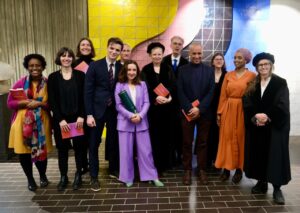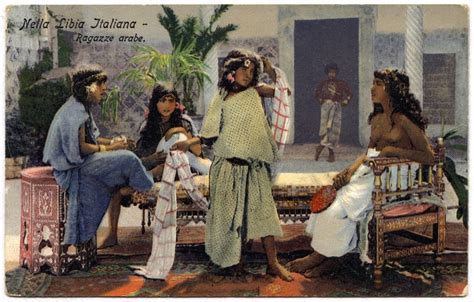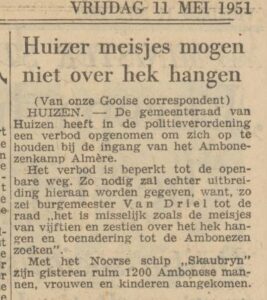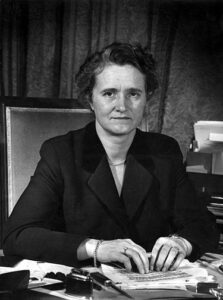
Monument voor de Gevallenen van de Tweede Wereldoorlog met op de achtergrond het onafhankelijkheidsplein en het presidentieel paleis, 2009. Bron: Guno Jones
Door Guno Jones
Wat betekende het om Nederlander uit een van de kolonies te zijn tijdens de Duitse bezetting van Nederland in de Tweede Wereldoorlog? Hoe verging het mensen in relaties die beschouwd werden als ‘gemengd’ en hun kinderen? Hoe hebben mensen uit de kolonies, hun partners en hun kinderen zich bewogen in een samenleving, waarin de mythe van raszuiverheid het ideologische fundament vormde van het politieke regime dat Nederland toen bestuurde? Onderzoek naar de oorlogservaringen van burgers uit de kolonies in Nederland is schaars. De gepubliceerde persoonlijke verhalen in dit blog illustreren de complexe impact van raciale regimes op mensen die verschillend geclassificeerd worden. Zij tonen tevens hoe antikolonialisme, antiracisme en verzet tegen antisemitisme kunnen overlappen.
Europees Kolonialisme en Nazisme
De laatste jaren is de verwevenheid van koloniale geschiedenis met de Nederlandse geschiedenis op niet eerder vertoonde wijze onderdeel geworden van het publieke debat, de kennisvorming, culturele instellingen en de media. Maar dat geldt nog niet zozeer voor de geschiedenis van de Tweede Wereldoorlog. Dat is een opmerkelijke lacune: Nazi Duitsland bezette Nederland tussen 1940 en 1945, en de expansionistische Duitse politiek was ideologisch zowel geïnspireerd op Duitse koloniale politiek als op de omvangrijkere en oudere koloniale projecten aan geallieerde kant. Voor Europese mogendheden, of ze tijdens de Tweede Wereldoorlog nu tot de As-mogendheden behoorden of tot geallieerden, was het bezit van kolonies en hun goederen essentieel voor de opbouw van de ‘eigen’ natiestaat. De Nazi’s presenteerden de toepassing van de Lebensraum[1] theorie expliciet als koloniaal project en waren zich er terdege van bewust dat de VS en Europese mogendheden aan geallieerde zijde hen daarin voor waren gegaan. Vooral het Britse imperium sprak tot de verbeelding van de Nazi’s. [2] Nazi Duitsland zette de koloniale politiek op technisch geavanceerde wijze voort in Europa,[3] maar dit intra-Europese kolonialisme was voor de geallieerden onacceptabel. Het was kennelijk legitiem, om, zoals Césaire al in 1955 (in zijn kritiek op het racistische ‘pseudo-humanisme’ van Franse intellectuele traditie) observeerde, ‘Koloniale werkwijzen’ toe te passen op ‘Arabieren, Aziaten en Afrikanen’, maar niet op ‘witte Europeanen’. [4]
Deze rassentheorieën en praktijken reisden van de kolonies naar de metropolen van Europese imperia. In ‘Duits Zuid-West Afrika’(vandaag Namibië) waren de Herero en Nama die tegen de Duitse bezetters in verzet waren gekomen als gevolg van een uitroeiingsorder ( verniechtungsbefehl) bijna uitgeroeid (tussen 1904 en 1908, van de 80.000 bleven er 11.000 over), en in concentratiekampen deed men medische experimenten op Herero’s. In de kolonies Duits Zuid-West Afrika, Duits-Oost-Afrika, Togo, Kameroen en Samoa werden in 1905, 1907 en 1908 en 1912 een serie juridische verboden op gemengde huwelijken ingesteld. Reeds gesloten huwelijken werden in Namibië zelfs met terugwerkende kracht nietig verklaard. Koloniale eugenetische pseudowetenschappelijke kennis waarin ‘gemengde’ Afro-Duitse kinderen als van ‘geringere raciale kwaliteit’ waren aangemerkt en de voortzetting van dergelijk onderzoek in het Duitsland zelf onder de Nazi’s informeerde rechtstreeks de rassenwetten van Neurenberg van 1935 en de politiek van de Nazi’s jegens ‘gemengde relaties’ en ‘gemengde kinderen’ in Duitsland en Europa.[5] Ideologieën van raszuiverheid werden vertaald naar de uitsluiting van Joodse Duitsers uit het Duitse staatsburgerschap en een verbod op ‘gemengde’ huwelijken tussen Joodse Duitsers en mensen van ‘Arisch of aanverwant bloed’, de genocide op de Joodse bevolking, en de sterilisatie van ‘gemengde’ Afro-Duitsers.[6] Dit toont de directe continuïteit van koloniaal racisme en antisemitisme, al varieerde de inhoud van het biologisch racisme al naar gelang de categorieën, alsmede de concrete modaliteiten om die ‘raszuiverheid’ te bereiken. In Nederland hadden deze raciale ideologieën vooral voor Joodse Nederlanders en Roma en Sinti catastrofale gevolgen.[7] Maar wat betekende de Duitse bezetting van Nederland voor mensen uit de kolonies en hun partners en kinderen die niet geclassificeerd of herkend werden als Joods, maar ook niet pasten in het raszuiverheidsideaal van de Nazi’s ? En hoe hebben betrokkenen zelf zich bewogen in en betekenis gegeven aan die oorlogsomstandigheden?
De paradox van de omgang met de Tweede Wereldoorlog
Toen ik in 2015 een lezing verzorgde over de rol en ervaringen van mensen uit de kolonies in de Tweede Wereldoorlog concludeerde ik dat deze verhalen nagenoeg ontbreken in historiografie en de herdenkings- en herinneringscultuur van de Tweede Wereldoorlog in Nederland. Anno 2023 is er niet veel veranderd. Terwijl het internationale karakter van de Tweede Wereldoorlog onomstreden is en kennis over en herdachte categorieën door de tijd heen is verschoven, staat de publieke omgang met de oorlog toch vooral in het teken van onveranderlijke nationale beslotenheid. Terugkijkend blijkt door de jaren heen steeds een nieuwe consensus te ontstaan over ‘het echte oorlogsverhaal’ en wie daarbij horen en wie niet, maar die nieuwe consensus voegt zich vervolgens in een statisch, nationalistisch raamwerk. Waar in de jaren 1950 en 1960 het accent in de publieke omgang met de Tweede Wereldoorlog vooral lag op heldenmoed en nationale wederopstanding, duurde het veel langer voordat ook uiteenlopende categorieën slachtoffers, [8] zoals de 102.000 (veelal in Duitse concentratiekampen) vermoordde Joodse Nederlanders, een plaats kregen in de herdenkings- en herinneringscultuur en in de kennisvorming.[9] Pas vrij recent krijgt het verzetswerk van vrouwen, en dan met name witte vrouwen, meer publieke aandacht. [10] De rol van burgers uit de kolonies in Nederland is nagenoeg onbekend, en het is de vraag of de recente canonisering van Anton de Kom, die zich zowel tegen het kolonialisme en racisme verzette als tegen antisemitisme, duidt op een verschoven definitie van de Nederlandse natie. Deze jarenlange afwezigheid van burgers uit de kolonies in het verhaal over de Tweede Wereldoorlog is althans deels gebaseerd op een geracialiseerd idee over ‘echt Nederlanderschap’. Toen er, bijvoorbeeld, in 2008 een reizende tentoonstelling over de rol van de kolonies en burgers uit de kolonies in de Tweede Wereldoorlog in Nederland rondging, sprak uit een deel van de reacties onbegrip en weerstand. Sommigen vonden het verhaal van de kolonies en mensen uit de kolonies niet thuishoren in het Nederlandse oorlogsverhaal.[11] Critici van de gangbare herdenking van WOII wezen er de afgelopen jaren daarentegen op dat de kaders van het verhaal over de Tweede Wereldoorlog te smal zijn, als daarin geen ruimte is voor een kritische reflectie op de relatie tussen kolonialisme, Tweede Wereldoorlog en hedendaags rechtspopulisme. Het illustreert dat publieke omgang met Tweede Wereldoorlog ‘formeel’ weliswaar in het teken staat van nationale vrede en saamhorigheid, maar tegelijkertijd een strijdtoneel is over definities van de natie, over wat onze oorlogsverhalen zijn en wat niet, en wie daar onderdeel van zijn en wie niet. De oorlogsverhalen van mensen uit de kolonies in het Nederland van de Tweede Wereldoorlog kunnen we in die lijn beschouwen als een nagenoeg verzwegen geschiedenis.
Het verzetswerk van mensen uit de kolonies
Hoewel er inmiddels onderzoek is verricht dat een beeld geeft van de impact, de rol, en ervaringen van (mensen in en uit) de overzeese kolonies tijdens de Tweede Wereldoorlog en het erfgoed dat daarmee samenhangt,[12] is er vooralsnog geen onderzoeksgeld beschikbaar gesteld voor systematisch onderzoek naar de oorlogservaringen van mensen uit de kolonies, ‘rijksgenoten’ zoals ze destijds werden genoemd, in Nederland. Gelukkig krijgen we via een combinatie van verspreide bronnen zoals enkele memoires, literaire non-fictie, films en enkele websites een eerste beeld. Ik krijg tevens geregeld verhalen en informatie over de ervaringen en het verzetswerk van onbekende mensen uit de kolonies in Nederland toegestuurd.[13] Het gaat qua afkomst en klasse om een brede groep mensen die genealogische connecties met koloniaal Indonesië, Suriname en de Caraïbische eilanden heeft. Een voorlopig overzicht suggereert dat van de 800 Indonesische studenten, waarvan de meeste lid waren van Perhimpoenan Indonesia, er 100 in het verzet zaten.[14] Raden Mas Djojowirono Sunito, die was getrouwd met de jurist Trees Heyligers, was een van de belangrijke figuren in deze groep, maar ook het echtpaar Raden Mas Pratomo & Stijntje Gret zaten in het verzet.[15] Ook uiteenlopende Surinaamse en Antilliaanse Nederlanders zaten in het verzet, al dan niet met hun partners. Bekende namen zijn Boy Ecury, George Maduro, het echtpaar Waldemar Nods en Rika van der Lans (bekend van het boek en de film Sonny Boy), en natuurlijk ook eerdergenoemde Anton de Kom, die getrouwd was met Petronella Borsboom. Maar er zijn ook minder bekende oorlogsverhalen, zoals dat van de familie van Ommeren, Betty Bergen, Wim Egger, en Herman Henink Monkau.
Perspectieven
Wat uit een voorlopige verkenning van beschikbare bronnen naar voren komt is dat verzetsmensen uit de kolonies antifascisme en antikolonialisme in verband met elkaar brachten. Nederland was, net als Frankrijk en Groot-Brittannië, nog formeel een koloniale mogendheid en zowel Anton de Kom als Raden Mas Djojowirono Sunito waren actief in het verzet tegen de nazi’s en pleitbezorgers voor het einde van koloniale verhoudingen. Voor hen waren vrijheid voor Nederland en zelfbeschikkingsrecht voor de kolonies twee kanten van dezelfde medaille. Deze brede betekenis van ‘vrijheid’ was ook zichtbaar onder Surinaamse Nederlandse militairen die aan geallieerde zijde meevochten. Mensen uit de kolonies met dit profiel streden vol overtuiging tegen fascisme en nazisme, maar waren zich tegelijkertijd bewust van het onrecht aan geallieerde kant, zoals koloniale overheersing, racisme en segregatie.[16] Men was nationaliteitsdrager maar was als gekoloniseerde tegelijkertijd tweederangsburger. Hun double consciousness, om met W.E.B. Dubois te spreken, bepaalde hun perspectief op de Tweede Werelddoorlog.
Impact raciale classificaties op verzetswerk, ‘gemengde relaties’ en hun kinderen
Raciale classificaties waren in de Tweede Wereldoorlog een zaak van leven en dood, de Nazi-ideologie was hierop gestoeld en de Nederlandse ambtenarij werkte op grond hiervan actief mee aan systematische vervolging van Joodse Nederlanders. Dat raciale regime had ook ‘gemengde relaties’, in lijn met de ideologie van Arische zuiverheid, bij wet verboden. De Nazi’s pasten in Duitsland een gedifferentieerde politiek toe. Waar voor de Joodse bevolking (net als voor de Herero en Nama in ‘Zuid West Afrika’ enkele decennia daarvoor) een bevel tot collectieve vernietiging was gegeven, paste men een meer complexe, soms tegenstrijdige, politiek toe ten opzichte van de Zwarte (geïnterneerde) bevolking die afhing van categorie waartoe men gerekend werd.[17] De bronnen suggereren dat het Duitse regime in Nederland richtlijnen hadden gegeven om gekleurde burgers uit de kolonies, hun partners en hun kinderen niet actief te vervolgen. Tenminste, als ze niet als Joods bekend stonden, en als ze niet in het verzet zaten, want mensen uit de kolonies die wel als Joods bekend stonden werden wel actief vervolgd en vermoord. Wat de richtlijnen precies waren, moet nader worden onderzocht. Het raciale classificatiesysteem van de Duitsers schijnt er in ieder geval geen rekening mee te hebben gehouden dat ook mensen van kleur uit de kolonies Joods konden zijn, wat ze heeft behoed voor actieve vervolging. Van de betrekkelijke bewegingsvrijheid die dat bood, hebben sommige mensen van kleur uit de kolonies gebruik gemaakt om verzetshandelingen te plegen. Ik bespreek drie voorbeelden.
Bettina Bergen was verpleegkundige in het Wilhelminaziekenhuis in Amsterdam. Haar nicht Michal M. Bergen beschrijft in Tante Bettina vertelt haar ervaringen. Bettina Bergen bood 8 Joodse onderduikers onderdak (ze woonde alleen in een groot huis nadat haar man was overleden) en werd uiteindelijk verraden door ‘een dame die zich eerder neerbuigend over ons, Surinamers in haar straat had uitgelaten.’ Ze werd geïnterneerd en onderworpen aan experimenten, maar overleefde. Ze was van Creools-Joods- Surinaamse afkomst en ‘voldeed niet aan het beeld dat Duitsers van Joden hadden’, aldus de auteur: ‘tante Bettina viel niet op als Jodin, maar was vanwege haar hulp aan andere Joden in het Kamp terecht gekomen’. Ze citeert haar tante Bettina als volgt: ‘vrijwel iedereen wist dat ik pro-Joods en Anti-Duits was. De meeste mensen wisten alleen niet dat ik zelf ook een Jodin was.’ Uit het boek komt naar voren dat Bettina Bergen zich ook scherp bewust was van racisme en koloniaal onrecht.[18]
Ook de memoires Surinaamse Rug, Joodse buik, geschreven door Wim Egger, gaan in op verzet en vervolging. In Egger’s memoires is te zien hoe bewustzijn over het onrecht van de slavernij en het bewustzijn over het onrecht van de Duitse vervolging hand in hand gaan. Wim Egger is zoon van een Europees-Joods Nederlandse moeder en een Creools-Joods Surinaams Nederlandse vader. Zijn vader heeft tijdens de oorlog een aanzienlijk aantal Joodse Nederlanders aan een onderduikadres geholpen en in eigen huis een schuilkelder voor zijn Joodse schoonfamilie gebouwd. In januari 1943 wordt hij verraden. Tijdens de inval worden ‘met een uitbarsting van angstaanjagend geweld’ hij zelf, zijn moeder, zusje en ook een Joodse oma en tante gearresteerd. Egger’s vader, die op dat moment niet thuis was, wordt niet lang daarna gearresteerd, door de autoriteiten gemarteld en in juni 1944 vrijgelaten na zijn straf te hebben uitgezeten in kamp Vught. Egger senior kreeg straf voor verzetsdaden en bleef buiten het concentratiekamp omdat hij ‘niet geregistreerd [stond] als Joods’: ‘de Surinaams-Joodse afstammingslijn met de Afrikaans-Joodse roots van mijn vader was de Duitsers […] te machtig. […] de gemeentearchieven uit Paramaribo bleven onbereikbaar’ . ‘[…]als Surinamer werd je toen niet vervolgd.’ Zijn Europees Joodse moeder en haar familietak, de familie Jas, worden op transport naar Duitse concentratiekampen gezet en praktisch allemaal vermoord. Op het nippertje weet zijn moeder te voorkomen dat hij en zijn zusje ook afgevoerd worden, door haar trouwring af te geven en te benadrukken dat ze ‘met een Surinamer getrouwd was en haar kinderen niet mee wilde nemen’. Egger en zijn zusje worden vrijgelaten en gaan wonen bij hun ‘Surinaamse tante Hélène’ en hun ‘oer-Hollandse oom Frits’. Egger: ‘Ik [was] ineens ‘Surinaams’ geworden met de volle nadruk op alleen die ene kant van mijn complexe Joods-Amsterdams-Surinaamse roots.’ Net als zijn vader, zijn zusje en hijzelf overleeft ook zijn moeder de oorlog, maar oorlogstrauma’s zouden het gezin tekenen.[19]
Herman Hennink Monkau, tenslotte, beschrijft in de Kleurling zijn ervaringen als kind van een Witte Duits-Nederlandse moeder en een Creoolse, Zwarte Surinaamse vader. Hij laat zien dat racisme, antisemitisme en weerzin tegen ‘gemengde relaties’ al voor het uitbreken van Tweede Wereldoorlog aanwezig zijn in Nederland en de continuïteit ervan. Net als de eerdere auteurs beschrijft Hennink Monkau dat de Duitse bezetter ‘kleurlingen’ uit de kolonies, inclusief Creools-Joods Surinaamse Nederlanders, met rust liet, en hij contrasteert dat met de lotgevallen van de familie van zijn Europees Joodse vrienden. Hij verwijst in dit verband ook naar levensreddende identiteitspolitiek van een Creools-Joods Surinaams Nederlandse vriend die tijdens een controle van de persoonsbewijzen benadrukt dat hij Zwart is, daarbij naar zichzelf verwijzend met het ‘N-woord’. Hennink Monkau schrijft daarover: ‘Hij was er van op de hoogte dat de bezetter van hogerhand de instructie had gekregen om de uit Suriname afkomstige Nederlanders met rust te laten, tot niet geringe ergernis van degenen die hem staande hielden’. Ook Hennink Monkau wordt geraakt door de raciale classificatiepolitiek. In 1943 loopt hij met zijn moeder door Amsterdam en worden ze aangesproken door twee Duitse officieren. Een van hen vraagt haar in het Duits, wijzend op haar zoon: ‘Wat is dat voor een soort’? Ze bijt de officier in het Hoogduits toe dat het om haar zoon gaat en dat je flora en fauna in soorten classificeert, maar mensen niet. De officieren boden haar ruimhartig hun excuses aan.[20]
Ik denk dat deze verhalen andere perspectieven op de Tweede Wereldoorlog aan het licht brengen. De inclusie van deze verhalen is belangrijk, maar niet om daarmee een nieuwe consensus te bereiken die zich voegt naar de nationale beslotenheid van de gangbare herdenkingstraditie. De basisstructuur blijft dan namelijk die van ‘insiders’ en ‘outsiders’ van ‘ons oorlogsverhaal’, ook al verandert de samenstelling van beide groepen iets. De betekenis van vernieuwing van de kennisvorming en herdenking is daarom niet primair gelegen in het ‘toevoegen’ van iets nieuws binnen bestaande kaders en gewoontes (ook al kan dat op zichzelf een begin zijn); veel belangrijker is welke kritische vragen op basis van historisch onrecht gesteld kunnen worden over het onrecht in het heden. Anton de Kom en anderen vertaalden hun ervaringen met en strijd tegen koloniaal onrecht in het herkennen en bestrijden van antisemitisme en Naziterreur. Welke vertaalslag maken wij waar het om het herkennen en bestrijden van hedendaags onrecht gaat? We zullen steeds alert moeten blijven op totalitaire én mainstream politieke bewegingen die verheffing, ‘zuiverheid’ en afgeslotenheid, in welke vorm dan ook, als ideaal samenlevingsmodel poneren.
[1] Gebiedsverovering, ontrechting, onderwerping en/of uitroeiing van ‘inferieure’ rassen.
[2] Zie David Olusaga & Casper W. Erichsen, The Kaisers’s Holocaust, Germany’s forgotten genocide, London: Faber and Faber, pp. 1-13; Clarence Lusane, Hitler’s Black Victims. The Historical Experiences of Afro-Germans, European Blacks, Africans, and African Americans in the Nazi Era, New York/London: Routledge, 2003, pp. 129-134; Lusane laat zien dat de Nazi’s, voor wat betreft hun raszuiverheidspolitiek, inspiratie putten uit de ‘anti-miscegenation’ laws in de Verenigde Staten.
[3] Zygmunt Baumann, Modernity and Holocaust. Men bediende zich van moderne industriële methoden, waardoor massamoord en ‘zuiverheidspolitiek’ zeer efficiënt werden.
[4] Aimé Césaire, Over het Kolonialisme, Amsterdam: De Geus, 2022, p. 28-29.(Oorspronkelijke titel Discours sur le colonialisme, verschenen in 1955 bij Éditions Présence Africaine, Parijs)
[5] Lusane, Hitler’s Black Victims, pp. 43-52.
[6] Lusane, pp. 43-67, 129-143, 267-270; Paul Gilroy, Against Race, pp. 137-176.
[7] Eveline Gans, “ ‘They Have Forgotten to Gas You’: Post-1945 Antisemitism in the Netherlands.” Philomena Essed & Isabel Hoving (eds.) Dutch Racism , Amsterdam/New York, 2014, pp. 71-100.
[8] Frank van Vree & Rob van der Laarse, De Dynamiek van de herinnering. Nederland en de Tweede Wereldoorlog in een internationale context. Amsterdam: Bert Bakker, 2009.
[9]Van Vree & van der Laarse; Rob Bakker, Boekhouders van de Holocaust. Nederlandse ambtenaren en de collaboratie, verscheen recent bij uitgeverij Verbum Holocaust Bibliotheek, gebonden uitgave, 727 blz.
[10] Trouw, 18 april 2015; Vrouwen in het verzet: de verhalen van Jacoba en Tante Riek - YouTube. Pas recent krijgt het verzetswerk van bijvoorbeeld Frieda Belinfante, Marie Anne Tellegen, Jacoba van Tongeren en Heleen Kuipers-Rietberg in biografieën en recentelijk ook in de berichtgeving over de herdenking
[11] Esther Captain en Guno Jones Trouw 10 mei 2008 Bevrijding was een mondiale gebeurtenis (opinie) | Trouw
[12] Zie bijvoorbeeld Esther Captain en Guno Jones, Oorlogserfgoed Overzee, De erfenis van de Tweede Wereldoorlog in Aruba, Curaçao, Indonesië en Suriname. Amsterdam: Bert Bakker, 2010; Jules Rijssen, Teken en Zie de wereld; Oorlogsveteranen in Suriname. Amsterdam: KIT Publishers / Jules Rijssen, 2012
[13] Je zou dit epistemologisch verzet kunnen noemen, refusing to be silenced.
[14] https://islamadani.wordpress.com/2021/08/17/indonesians-in-the-dutch-resistance-against-the-nazis/
[15] https://socialhistory.org/bwsa/biografie/sunito; http://www.gedaechtnisbuch.org/wp-content/uploads/2016/01/Pratomo_Djajeng-S1_4-27_01_16.pdf
[16] Esther Captain & Guno Jones, 2010.
[17] Lusane, pp.96 e.v.
[18] Michal M. Bergen, Tante Bettina vertelt, Terugblik op haar traumatische jeugd en oorlogsverleden, Hoofddorp: Mi’akeev, 2009, p.16, 30,40, 41,49,57,64,76, 77,78
[19] Wim Egger, Surinaamse Rug Joodse Buik. Emoties van een nazaat van de Surinaamse slavernij die een kind-overlevende werd van de Sjoa, Voorburg: Libertador, 2009, p.17, 114, 152
[20] Herman Henink Monkau, De kleurling, Amsterdam: Prometheus, 2006, p. 217, 84-85








